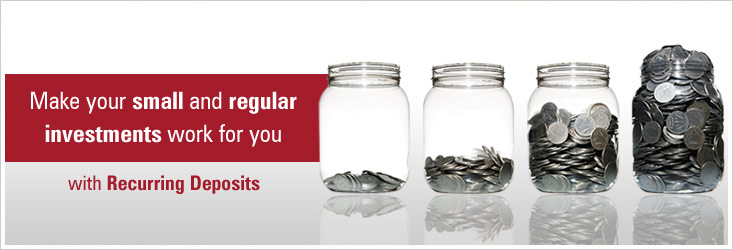Recurring Deposit (RD) and Fixed Deposit (FD) are the two most admired investment plans in India, especially for the investors who do not have an appetite for risk. The key benefit of endowing funds in a RD or FD plan is that they offer fixed income at absolutely no risk at all. However, it sometimes becomes difficult for investors to understand the difference and choose between the two. They often get confused about whether they should invest in a RD or a FD plan. Both the schemes are fixed returns commodities that are presented by every major bank or financial institution. As an investor, you need to put in a certain amount and you continue to earn a fixed interest on that amount through either of the scheme. With the completion of the tenure of the plan, you will collect both the principal and the interest amount. An investor needs to furnish some essential documents at the time of investing in a FD or RD including identity proof, address proof, passport, PAN card, and earnings documents.
Recurring Deposit vs Fixed Deposit:
Delving deeper into the difference between RD and FD, prior to talking about other dissimilarities, we must discuss a key dissimilarity that every investor should know. The chief distinguishing factor between RD and FD plan is that while both the schemes stretch over a term, FD investors can pay the entire amount one time whereas RD investors need to credit a fixed sum at recurring intervals. Thus, in a Recurring Deposit, you can deposit a certain amount each month and earn interests. This interest will be paid to you together with the principal amount at the time of maturity. Talking about Fixed Deposit, the plan allows you to choose a term that can be of seven days or stretch up to ten years. However, you need to deposit the complete amount at once. The returns on the amount invested will be deposited in your account on a quarterly or monthly basis.
The investor is free to withdraw the amount at the end of the chosen tenure for RD or FD. Though premature withdrawal is possible, it attracts penalty in both the plans.
Fixed Deposit vs Recurring Deposit – Other Differences:
Recurring Deposit
- Term: The tenure for RDs generally varies from one year to ten years. The investor has to credit a specified amount at fixed intervals over the chosen term.
- Interest Rate: The interest rate generally depends on term plan and monthly or quarterly investment amount. The rate of return fluctuates in the range of 8 to 8.5% for a term of one year.
- Investment Cap: Even as there is no predetermined maximum or minimum ceiling, the investment limit is generally decided by the issuing bank. Several banks boast of the minimum deposit limit to be Rs. 1000 while the maximum amount can be as high as Rs. 15 lakhs a month
- Interest Income: The interest earned on RD is taxable but the majority of banks do not enclose the provision of TDS.
- Tax benefit: RD does not offer any tax benefit to the investor.
Fixed Deposit
- Term: Usually, the tenure varies from a week to up to ten years so the investor is free to choose a term that is most suited to him/her.
- Interest Rate: The rate of return ranges between 8 to 8.5 % for the duration of one year. Usually, the interest rate relies on the tenure chosen and the capital amount. Moreover, FD offers a little higher interest rate as compared to RD.
- Investment Cap: Generally, there is no upper ceiling on the amount that an investor can put in a FD plan but the cap amount can be regulated by the bank with the minimum amount starting from Rs. 100 (or multiples) whereas the maximum sum can go up to Rs. 1.5 lakh.
- Interest Income: The income earned on FD is taxable and the tax is deducted from the source.
- Tax benefits: FD products are exempted from tax under the Income Tax Act 1961, section 80C.
What Should an Investor Choose – RD or FD?
Considering that every investor has different investment priorities and requirements, the decision to opt for RD or FD becomes quite subjective. Both RD as well as FD is perfect for risk hesitant investors, who mainly fall lower in the tax slab. For the investors who cannot afford to shell out a big sum to put in a FD but have the funds for small investments every month, a RD (recurring deposit) scheme seems to fit right. You can use an online recurring deposit calculator to check the amount that suits you best for investment. Even though, a single investment plan would not fulfil all your needs, you can still go for a RD because it presents significantly lesser financial burden and offers similar income as FD.
As compared to RDs, FDs produce superior returns and therefore amass greater capital for the investor. It is primarily owing to the fact that the sum invested in a FD earns returns for one complete year. The power of compounding enables FDs to produce superior returns for the investor. Conversely, only the first deposit brings in interest for the year (12 months) in a RD. The second deposit brings in interest for 11 months, the third for 10 and so on.
Coming to the investor, we believe that the accessibility of funds and investment needs should decide which option they should settle on. If you can set aside a big sum amount for investment, you should consider FDs as they produce greater earnings as compared to RDs. However, be a bit vigilant and analyse every detail before investing in a FD plan. Talking about salaried employees, they may feel more secure in endowing small and set investments each month. For this reason, an RD appears to be more appropriate choice in their case.
Hope you have a better idea on RD vs FD and the advantages of one over other. If you still have questions on FD vs RD differences and which is more suitable for your needs, share your questions in comments section below.

